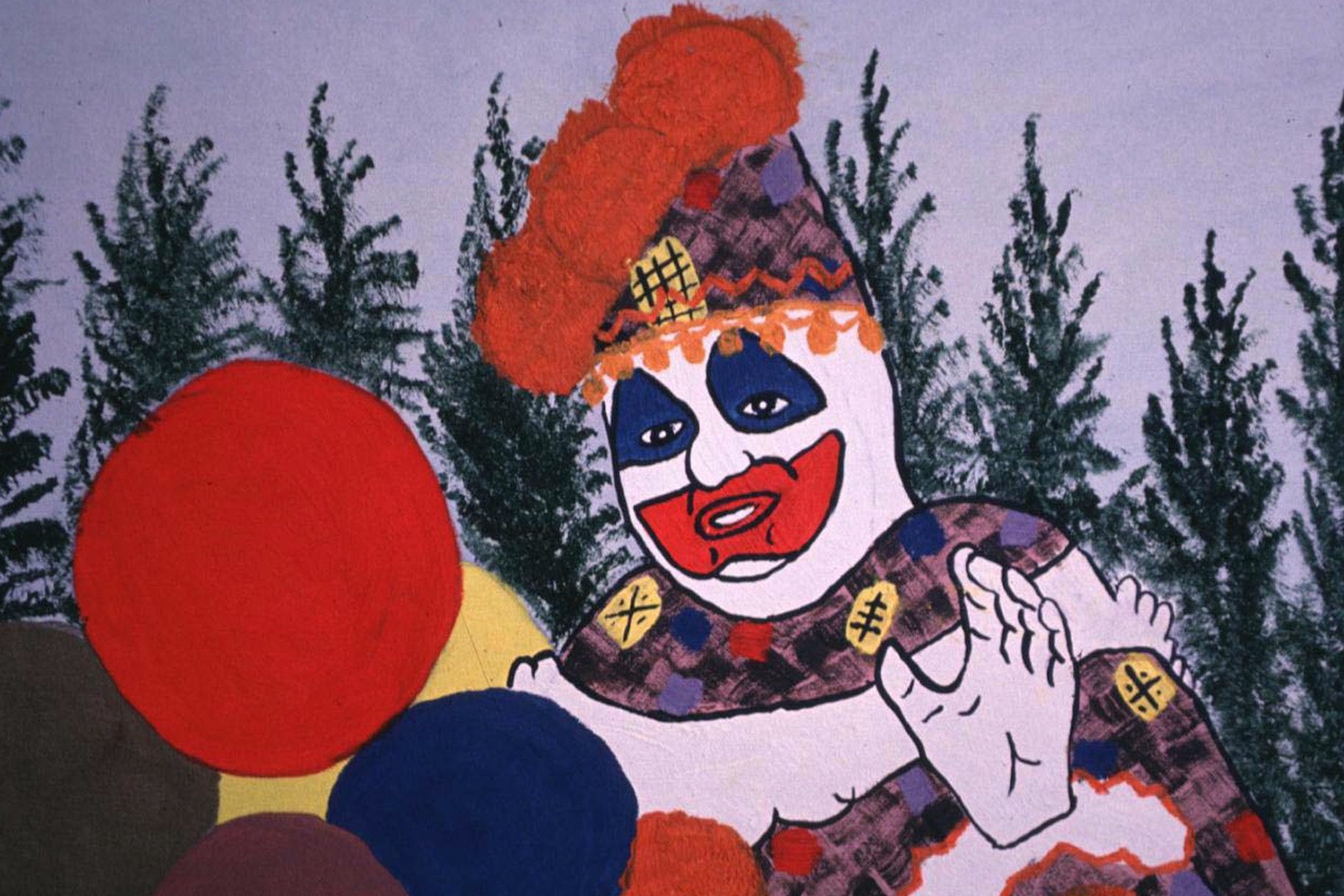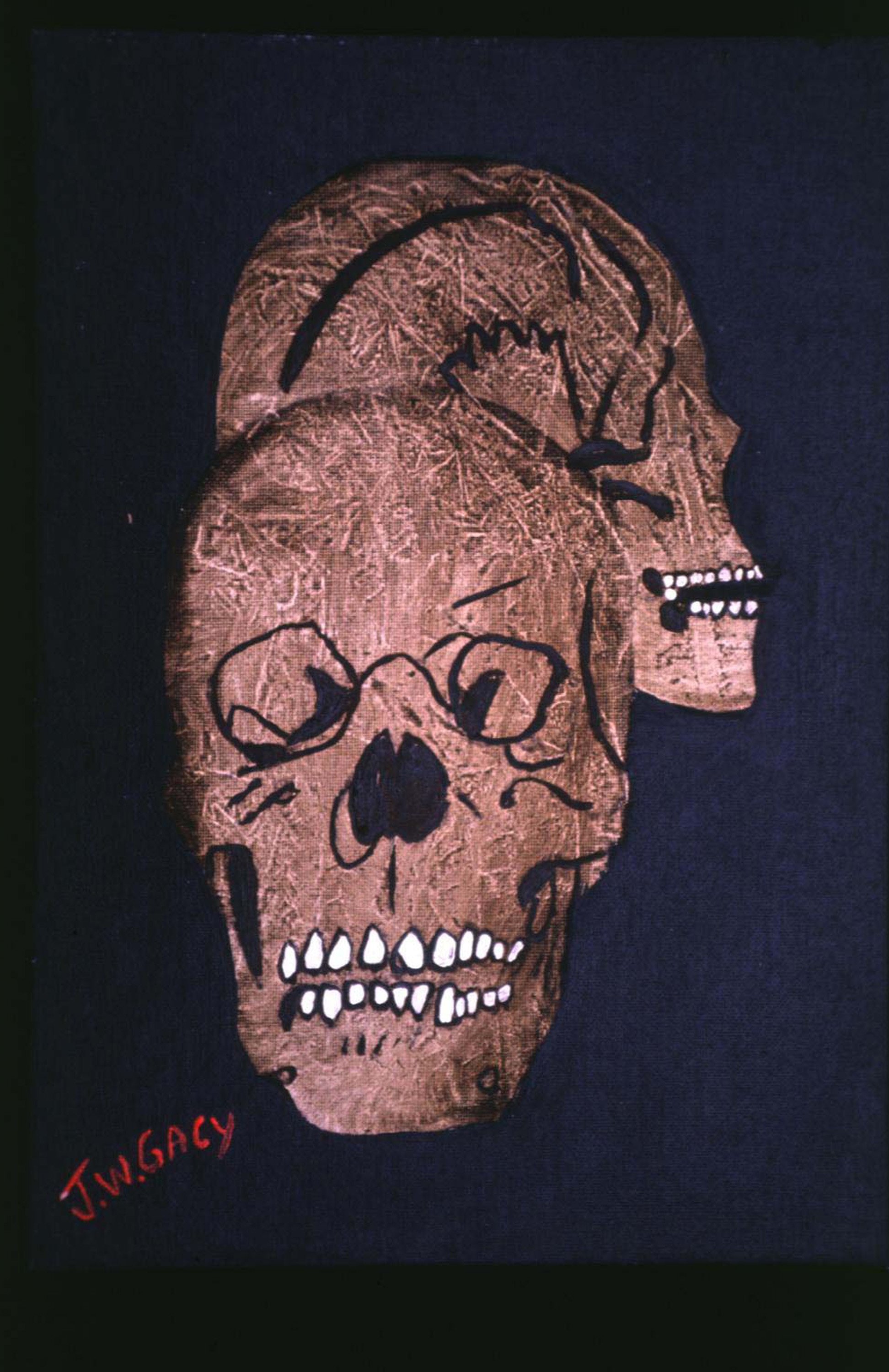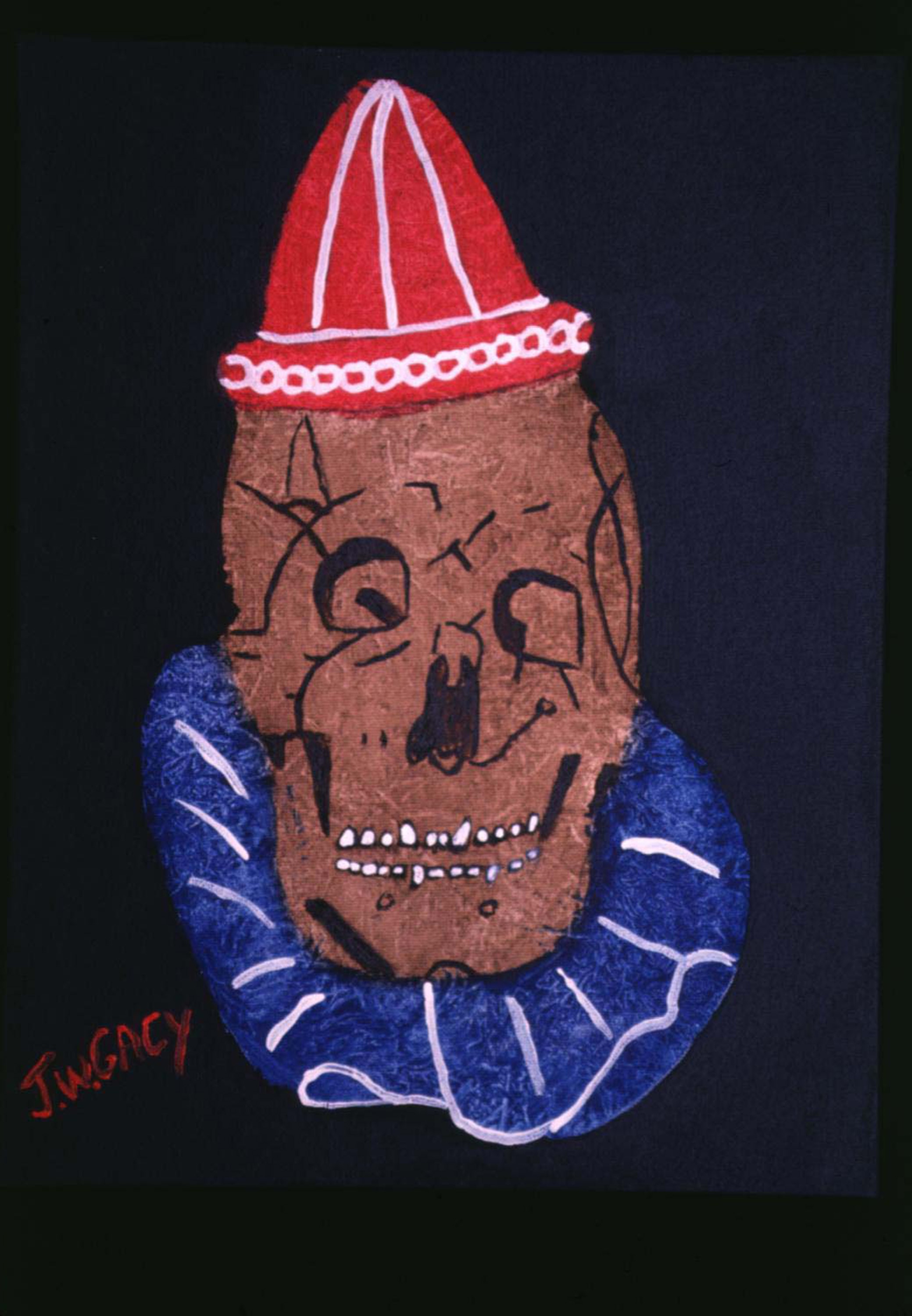Create a free profile to get unlimited access to exclusive videos, breaking news, sweepstakes, and more!
Why Are People Fascinated By The Artwork Of Serial Killer John Wayne Gacy?
Serial killer clown John Wayne Gacy created several paintings while in jail, the prices of which have since skyrocketed in both legitimate and black markets. But what is the appeal of artwork created by such a notorious murderer?

The #MeToo movement has led to a renewed debate about the ethics of supporting art made by morally rephrensible people — Kevin Spacey's scenes in "All The Money In The World" were even redone to replace him with Christoper Plummer after sexual assault accusations were made against him, and plenty of people have sworn off watching Woody Allen movies after his daughter, Dylan Farrow, accused him of child molestation.
But while heated debates ensue about the merits of works made by abusers, others find themselves drawn to art crafted by the most deplorable criminals. The paintings of serial killer John Wayne Gacy have garnered a cult following, with black market collectors and haunted house purveyors covertly trading his unsettling clown portraits. Why have Gacy's paintings specifically acquired such fascination?
Gacy confessed to the murder of over two dozen young boys from 1972 to 1978, infamously burying many of the bodies in a crawl space beneath his home. It was determined that he had tortured and sexually abused several of them before the killings. Gacy was ultimately executed by lethal injection in 1994, but his case continues to transfix true crime enthusiasts.
Although the Gacy ordeal is peppered with innumerable hideous details, it was Gacy's long-term employment as a clown that has made his image in the popular imagination indelible. Gacy's seemingly innocuous penchant for entertaining children apparently belied a horde of hideous sexual fantasies and urges.
While isolated on death row, Gacy began to paint — mostly portraits of his alter ego, Pogo The Clown — with the intention of "to bring joy to people’s lives," he reportedly once told a reporter as recounted in "Burried Dreams: Inside the Mind of a Serial Killer" by Tim Cahill.
The value of the paintings skyrocketed after businessmen Joe Roth and Wally Knoebel purchased a handful of the works with the intention of allowing them to be burned by the families of the victims as a cathartic gesture, Vice reports. In 2011, a controversial charity auction of Gacy's paintings had valued some of the canvases at between $2,000 and $4,500, according to CNN. In 2012, a New York-based haunted house advertised its serial killer-themed attraction by displaying some of Gacy's portraits in the facility's entrance, the New York Daily News reported. And more recently, in 2017, a painting by Gacy was estimated to auction for approximately $9,000, according to Metro UK, a British news organization.

Kari Cahoon, whose brother Rick Johnston was killed by John Wayne Gacy Jr., throwing one of Gacy's artworks into an outdoor bonfire as the crowd applauds. [Photo by John Zich/The LIFE Images Collection/Getty Images]
The shady practice of collecting artifacts from deadly criminals has been given the derisive nickname murderabilia (sometimes spelled murderbilia). This illicit hobby has garnered ire from law enforcement and legal officials: In a January 2018 New York Times article on the fate of Charles Manson's body, victim advocate Andy Kahan described the hobby as “capitalism at its worst."
An artist and collector known only as Professor Tooth, who owns "a couple" of Gacy paintings, explained how the market for murderbilia has changed significantly in recent memory.
"Most of the art I get is from other collectors," Tooth told Oxygen.com. "A while back, the circles of people [interested in serial killers] was way smaller than it is now. There weren't the same avenues to procure certain things. A lot of it was done through emails or phone calls — you kind of had to build respect and a reputation. Another person might have something you'd want and they'd have something you'd want, so there'd be a lot of trading.”
"The reason the prices of some of this stuff have gone up is because it's a fad again. The fear of it is kind of gone," Tooth continued. "Everything nowadays is based on true crime or serial killers: Netflix specials, podcasts, all that stuff. It's gotten more people interested. The community of people who used to care about [serial killers] was very small. But now people will go crazy for it at auctions just so they can say they own it.”
Tooth's own artistic practice includes the creation of collectible coins inspired by some of the scariest figures in history, including Gacy.
“I wanted to bring back the dark side of it all. There's not as much fear left in a lot of [true crime] stuff, and I wanted to bring back the nightmarish parts of it. For me, there's a lot of fear — every day. We have some of the most famous presidents and some of the most well known people in history featured on coins so I went the opposite route and put some of the most ferocious and demented people on coins. I wanted to show the dark side of history.”

Original Artwork by serial killer John Wayne Gacy during John Wayne Gacy - Original Artwork Exhibition at Club USA at Club USA in New York, New York, United States. [Photo by Steve Eichner/WireImage/Getty Images]
As for the quality and enduring appeal of Gacy's art, Tooth did express some admiration.
"This might sound bad but I've always admired people that can let down their guard and just go for it. He wasn't concerned about the full outcome or if it wasn't 100 percent perfect. In my art, I'm the opposite... He had, I guess, prettier phases where he would paint birds or flowers but it got darker eventually, when he started doing skulls and penises. He really ran the gambit. He might have just been painting what he knew people would want.”
But a major part of the fascination with these dark oddities is their inherent transgressive value, noted Professor Truth: “There's a fear factor. There is a true and honest fear with all of it, whether it's artworks or their letters or other artifacts. It's all about fear.”
But for Julia Culkin, a behavioral health clinician and a licensed creative arts therapist currently working for an outpatient mental health clinic and specializing in adults with substance abuse issues and severe mental illnesses, Gacy's paintings have forensic or psychological value that may give us hints about the killer's internal world.
"I think we're often fascinated by John Wayne Gacy just in the nature of his sadistic and sexual fantasies. We're drawn to that dark side. I could see the interest," said Culkin. “We're drawn more towards the content. It's that clown — Pogo the Clown — which we know he had identified himself as. I think the fascination with the clown is the juxtaposition of this jovial, happy, amiable character that entertains children while underneath there's obviously this sinister, diabolical sexual deviant.”
When asked whether she could detect specific pathologies from the portraits, Culkin stressed the subjective nature of her profession.
"I think art therapy gets a bad rap. We're not tarot card readers... I can't see something and say exactly what the person was the thinking was time. There's obvious idiosyncrasies within all artworks."
Nonetheless, Culkin gleaned some insights from the canvases.
"His choice of color is very interesting. It's a broad range of color — color is usually the language of affect. So there's a lot of emotion there. He doesn't use color fantastically, which doesn't indicate any kind of psychosis. A lot of people who have disorganized thought patterns or experience auditory or visual hallucinations, people more on the schizophrenic side of pathology sometimes may use fantastical colors in a natural composition, like a person's face being bright purple instead of brown or peachy."
"The character of Pogo is also depicted from the waist up," Culkin continued. "Knowing his background as a sexual deviant, it's fascinating that he decides to cut off the genitals... So he's hiding that, in a way. The images of Pogo in a lot of the paintings are in a three-quarter or straight-on view. He raises the left hand, harking back to a Christ-like pose. That may speak to his need for recognition, his narcissism, seeing himself as non-human, otherworldly, or omnipotent. He was living in a fantasy world at the time of the murders in a certain respect.”
To explain the morbid appeal of Gacy's art, Culkin turned toward controversial psychoanalyst Carl Jung.
“We're fascinated by the human Shadow [archetype]. It's unknown, it's unfeasible. We find ourselves walking through our daily lives and we simply cannot fathom that a person could be so malevolent or hurtful or even murderous.”
But to what extent can artists and audiences divorce the appalling actions of Gacy from the contents of the work? Can art from someone so heinous have any aesthetic value apart from morbid fascination?
For gothic multimedia performance artist Stephen Edwards aka Martyr, Gacy's art is still completely irredeemable.
“It's disgusting. [The art itself] is really ugly. People are collecting it just because of the name attached," said Edwards. "It doesn't make any sense to care about it otherwise. I think murder in general is being glorified right now, especially with the popularity of true crime podcasts and media. It's just sensationalizing destructive tendencies. I have such a problem with it."

Original Artwork by serial killer John Wayne Gacy during John Wayne Gacy - Original Artwork Exhibition at Club USA at Club USA in New York, New York, United States. [Photo by Steve Eichner/WireImage/Getty Images]
Much of Edwards' performance art attempts to address the underbelly of American culture and frequently comments on issues of sexual assault and abuse within religious communities. Yet despite a proclivity for darkness and his interest in a subject matter not so far removed from Gacy's behavior, Edwards finds the actual artwork of Gacy beyond the pale.
“It reminds me of Michael Alig, who also made art," Edwards continued. "He's still alive and wasn't on death row, but people are fascinated when someone demented makes art. It's a case of making a pop icon out of a killer. It's technically a part of American history. Back in the '90s people would collect serial killer trading cards; it becomes part of the consciousness of the country."
"But artistically or aesthetically? No," Edwards concluded. "These are just bad.”
[Featured Image: John Wayne Gacy - Original Artwork ('Pogo the Clown' self-portrait), Photo by Steve Eichner/WireImage/Getty Images]


























